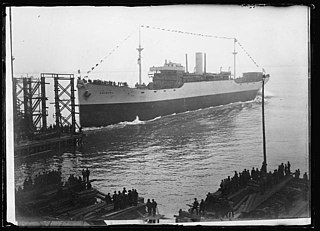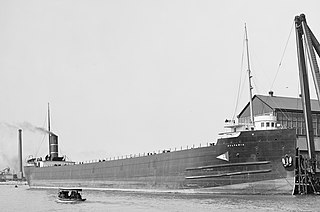
The SS William G. Mather is a retired Great Lakes bulk freighter now restored as a museum ship in Cleveland, Ohio, one of five in the Great Lakes region. She transported cargo such as ore, coal, stone, and grain to ports throughout the Great Lakes, and was nicknamed "The Ship That Built Cleveland" because Cleveland's steel mills were a frequent destination.

Lake freighters, or lakers, are bulk carrier vessels that operate on the Great Lakes of North America. These vessels are traditionally called boats, although classified as ships.

USCGC Mackinaw (WAGB-83) is a 290-foot (88 m) former Coast Guard icebreaker on exhibit as a museum ship at the Icebreaker Mackinaw Maritime Museum in Mackinaw City, Michigan. The vessel has been known as the "Queen of the Great Lakes"; the site states that "she was built during World War II to meet the heavy demands of war materials and transportation during the winter months".

The Grand Trunk Milwaukee Car Ferry Company was the Grand Trunk Western Railroad's subsidiary company operating its Lake Michigan railroad car ferry operations between Muskegon, Michigan, and Milwaukee, Wisconsin, from 1905 to 1978. Major railroad companies in Michigan used rail ferry vessels to transport rail cars across Lake Michigan from Michigan's western shore to eastern Wisconsin to avoid rail traffic congestion in Chicago.
The Defoe Shipbuilding Company was a small ship builder established in 1905 in Bay City, Michigan, United States. It ceased to operate in 1976 after failing to renew its contracts with the United States Navy. The site of the former company is now being developed for business and housing on the bank of the Saginaw River.

Chief Wawatam was a coal-fired steel ship that was based, for most of its 1911–1984 working life, in St. Ignace, Michigan. The vessel was named after a distinguished Ojibwa chief of the 1760s. In initial revenue service, the Chief Wawatam served as a train ferry, passenger ferry and icebreaker that operated year-round at the Straits of Mackinac between St. Ignace and Mackinaw City, Michigan. During the winter months, it sometimes took many hours to cross the five-mile-wide Straits, and Chief Wawatam was fitted with complete passenger hospitality spaces.

The Great Lakes Engineering Works (GLEW) was a leading shipbuilding company with a shipyard in Ecorse, Michigan, that operated between 1902 and 1960. Within three years of its formation, it was building fifty percent of the tonnage of all ships in the Great Lakes. During World War II, GLEW was commissioned by Pittsburgh Steamship Company and the U.S. Maritime Commission to build twenty-one ore freighters. Its innovations included the first self-unloader freighter, SS Wyandotte. GLEW is best known for its construction of the SS Edmund Fitzgerald.

The Merchant Shipbuilding Corporation was an American corporation established in 1917 by railroad heir W. Averell Harriman to build merchant ships for the Allied war effort in World War I. The MSC operated two shipyards: the former shipyard of John Roach & Sons at Chester, Pennsylvania, and a second, newly established emergency yard at Bristol, Pennsylvania, operated by the MSC on behalf of the U.S. Shipping Board's Emergency Fleet Corporation (EFC).
The American Ship Building Company was the dominant shipbuilder on the Great Lakes before the Second World War. It started as Cleveland Shipbuilding in Cleveland, Ohio in 1888 and opened the yard in Lorain, Ohio in 1898. It changed its name to the American Ship Building Company in 1900, when it acquired Superior Shipbuilding, in Superior, Wisconsin; Toledo Shipbuilding, in Toledo, Ohio; and West Bay Shipbuilding, in West Bay City, Michigan. With the coming of World War I, the company also acquired Buffalo Dry Dock, in Buffalo, New York; Chicago Shipbuilding, in Chicago, Illinois; and Detroit Shipbuilding, in Wyandotte, Michigan. American Shipbuilding ranked 81st among United States corporations in the value of World War II military production contracts.

Bay Shipbuilding Company (BSC) is a shipyard and dry dock company in Sturgeon Bay, Door County, Wisconsin. As of 2015, Bay Ships was a subsidiary of Fincantieri Marine Group and produces articulated tug and barges, OPA-90 compliant double hull tank ships and offshore support vessels. It also provides repair services to the lake freighter fleet. In the past the shipyard located in Sturgeon Bay has operated under several different names and traces its history back to 1918.

MV Roger Blough is a ship built in 1972 by American Ship Building Company in Lorain, Ohio. She serves as a lake freighter on the Great Lakes. The ship is owned by Great Lakes Fleet, Inc. and is named for the former chairman of U.S. Steel, Roger Blough.

Corvus was a steam cargo ship built in 1919 by Columbia River Shipbuilding Company of Portland for the United States Shipping Board as part of the wartime shipbuilding program of the Emergency Fleet Corporation (EFC) to restore the nation's Merchant Marine. The freighter was operated on international and domestic routes through 1944. Early in 1945 she was transferred to Soviet Union as part of lend-lease program and renamed Uzbekistan. After several months of operation, the freighter was rammed by another vessel on 31 May 1945 and was beached to avoid sinking. She was subsequently raised and towed to Portland where she was scrapped in 1946.

The SS Sylvania was a 572-foot (174 m) Great Lakes freighter that had a long 79-year career on the Great Lakes. Sylvania was built by the West Bay City Shipbuilding Company of West Bay City, Michigan as hull #613. She was built for the Duluth Steamship Company of Duluth, Minnesota.

Howard L. Shaw was a 451-foot (137 m) long propeller driven freighter that operated on the Great Lakes of North America from her launching in 1900 to her retirement 1969. She is currently serving as a breakwater in Ontario Place on Lake Ontario.

The Harriet B. was a wooden-hulled barge that served on the Great Lakes of North America, originally as the railroad ferry Shenango No.2, then a bulk carrier and finally as an unpowered barge. She sank four miles off Two Harbors, Minnesota, on May 3, 1922, after being rammed by the steel freighter Quincy A. Shaw. Her wreck was accidentally located upright and intact in 2005 in 656 feet (200 m) of water. On August 9, 2018, the wreck of the Harriet B. was listed on the National Register of Historic Places.
Rock Island Bridge was a steam cargo ship built in 1919 by Submarine Boat Company of Newark for the United States Shipping Board (USSB) as part of the wartime shipbuilding program of the Emergency Fleet Corporation (EFC) to restore the nation's Merchant Marine. In March 1920 while on her maiden voyage the vessel collided with another steamer and subsequently had to be beached to avoid sinking. She was later abandoned and sold for scrap.
Suremico was a Design 1023 cargo ship built for the United States Shipping Board (USSB) immediately after World War I. She was later named the Nisqually and converted into a barge and later a scow. She was bombed and sunk during the Battle of Wake Island.
The Design 1020 ship was a steel-hulled cargo ship design approved for mass production by the United States Shipping Board's Emergency Fleet Corporation (EFT) in World War I.





















